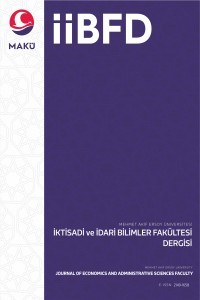ANLIK MESAJLAŞMA GRUPLARI: KOLAYLIK MI EZIYET Mİ?
anlık mesajlaşma uygulamaları, sosyal kimlik teorisi, sosyal normlar, normatif toplum baskısı
INSTANT MESSAGING GROUPS: IS IT CONVENIENCE OR TORTURE?
instant messaging groups, social identity teory, social norms, normative community pressure,
___
- KAYNAKÇA 1.Chung, D. S., & Nam, C. S. (2007). An Analysis Of The Variables Predicting Instant Messenger Use. New Media & society, 9, 212-234.
- 2. Pimmer, C., Brühlmann, F., Odetola T. D., Dipeolu. O., Gröhbiel. U., & Ajuwon. A. J. (2018). Instant Messaging And Nursing Students’ Clinical Learning Experience. Nurse Education Today, 64, 119–124.
- 3. Ajzen, I. (2005). Atitudes, Personality and Behavior. Open University Press.
- 4. Sardana, D., Cavusgil, E., & Gupta, N. (2020). The Growing Popularity Of Spiritual Brands: What Drives Purchase İntent?. International Business Review, 30.
- 5. Martin. B., Wentzel. D., & Tomczak. T. (2008). Effects Of Susceptibility To Normative Influence And Type Of Testimonial On Attitudes Toward Print Advertising. Journal of Advertising, 37, 29-43. 6. Aronson, E. (1980). The Social Animal. Palgrave Macmillan.
- 7. Solomon, M. (2017). Consumer Behavior: Buying, Having, and Being 12th Edition. Hoboken : Pearson.
- 8. Tomasello, M. (2014). The Ultra-Social Animal. European Journal Of Social Psychology, 44,187-194.
- 9. McKeown, S., Haji, R., & Ferguson. N. (2016). Understanding Peace and Confl ict Through Social Identity. Springer International Publishing.
- 10. McLeod, S. (2021, July 30). Social Identity Theory. Simply Psychology. https://www.simplypsychology.org/social-identity-theory.html
- 11. Glass, R., & Li. S. (2010). Social Influence and Instant Messaging Adoption. Journal of Computer Information Systems, 51, 24-30.
- 12. Brown, R. (2000). Social Identity Theory: Past Achievements, Current Problems And Future challenges. Eur J Soc Psychol, 30,745-778.
- 13. Lin, C. W., Wang, K. Y., Chang, S. H., & Lin, J. A. (2017). Investigating The Development Of Brand Loyalty In Brand Communities From A Positive Psychology Perspective. Journal of Business Research, 99, 446-455.
- 14. Bagozzi, R. P., Dholakia, U.M., Pearo, L. R. K. (2007). Antecedents and Consequences of Online Social Interaction. Media Psychology, 9, 77-114.
- 15. Algesheimer, R., Dholakia, U.M., & Herrmann, A. (2005). The Social Influence of Brand Community: Evidence from European Car Clubs. Journal of Marketing, 69,19-34.
- 16. Shen, Y. C., Huang, C.Y., Chu, C. H., & Liao, H. C. (2010). Virtual Community Loyalty: An Interpersonal-Interaction Perspective. International Journal of Electronic Commerce, 15(1), 49-74.
- 17. Lindiawati, Usman, I., & Astuti, S. W. (2019). Anticipating Normative Community Pressure İn Brand Community: A Study Of Young Entrepreneurs Community Of Bank Mandiri. Journal of Economics, Business, and Accountancy Ventura, 22,137-146.
- 18. Kağıtçıbaşı Ç 2014. Dünden Bugüne İnsan ve İnsanlar. Evren Publishing.
- 19. Maier, S. F., Seligman, M. E. (1976). Learned Helplessness: Theory And Evidence. Journal of Experimental Psychology: General, 105, 3-46.
- ISSN: 2149-1658
- Yayın Aralığı: Yılda 4 Sayı
- Başlangıç: 2014
- Yayıncı: Burdur Mehmet Akif Ersoy Üniversitesi
TÜRKİYE'DE TASARRUF YATIRIM AÇIĞI VE CARİ AÇIK EŞBÜTÜNLEŞİK MİDİR? DÖNEMLERARASI YAKLAŞIM
Cemal ÖZTÜRK, İsmail ÇEVİŞ, Hanım BOZKURT
Ömer Lütfi ANTALYALI, Pınar GÖKTAŞ
FİNANSAL İNOVASYON İLE EKONOMİK BÜYÜME ARASINDAKİ İLİŞKİ: TÜRKİYE ÖRNEĞİ
Gülay ÇİZGİCİ AKYÜZ, Seval AKBULUT BEKAR
TÜRKİYE’DE GÖÇMEN ENTEGRASYONU: ZORLAŞTIRICILAR, KOLAYLAŞTIRICILAR VE ÖNERİLER
Cenk Murat KOÇOĞLU, Merve YILDIRIM KALEM
Özcan IŞIK, Mohsin SHABİR, Murat BELKE
TÜRKİYE’DE ŞEHİR MERKEZLERİNDEKİ MUHTARLIK KURUMUNUN KAMUSAL EKONOMİ AÇISINDAN ETKİNLİĞİNİN ANALİZİ
